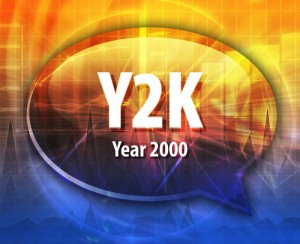Subscribe to our newsletter!
Stay updated with the latest security news, tips, and promotions.

New Year’s Eve usually comes decked-out with well-wishers and party goers sporting hats, champagne glasses, and noise makers. Perhaps this year you’ll gather with friends to watch the ball in Times Square drop, or maybe just sit glued to Facebook on your device, same as always. However you chose to celebrate, chances are it will be more fun (and less stressful) than how many people spent their New Year’s Eve on December 31st, 1999.
If you can remember back to 1999, you might remember the panic there was over Y2K. It sounds funny, almost 16 years later, but at the time Y2K was considered a serious danger. There was a palpable fear over what would (or would not) happen as the clock struck 12:00 am on January 1st, 2000. The fear revolved around how dates were stored in computers. Until the 1960’s, before computers were in common use, businesses used electromechanical devices called Unit Record Equipment to process and store their data via punch cards. Every drop of space for characters on a card was significant, so years were stored in two digits, as ‘“16” rather than the full year, “2016”.
As technology moved forward in the 1960’s and computers began to show up in businesses around the world, data storage was expensive, so many programmers mimicked the old punch card method, thus writing dates as 01/ 01/16 yet again, to save space.
Programmers in the 1960’s certainly didn’t think their space-saving efforts would be problematic come the year 2000, because they didn’t think there was any chance of their old programs still being used 35 years later. In fact, Alan Greenspan, former Chairman of The Federal Reserve said “I’m one of the culprits who created this problem….It never entered our minds that those programs would have lasted for more than a few years. As a consequence, they are very poorly documented.”
As early as the 1970’s, programmers began to wonder about the potential implications of the old space-saving method. The issue didn’t attract much attention until the late 1990’s, when corporations and governments saw that the programmers probably had a good point. By mid-1999, worldwide panic set in. Governments and businesses began doing all they could to prepare their networks for the seemingly inevitable crash. The United States alone spent over 100 billion dollars on the issue, 9 billion by the Federal Government and the rest by companies shaking in their boots.
As the second half of 1999 melted away, the media buzzed with end-of-time hype. Experts predicting stock market crashes, train derailment, plane crashes and other horrors. People began stock-piling food and dry goods in the case of shortages and police forces built and stocked underground bunkers, just in case.
A good deal of the fear was fueled by a distrust in technology and religious fervor. And let’s not forget all the enterprising folks who saw the possibly-impending-doom as a chance to make a buck. Souped-up guidebooks like “Y2K -It’s Not Too Late” and “Y2K – It’s Already Too Late” sold like hotcakes. In the end though, however, 1999 slipped into 2000 in the same relatively peaceful way that years tend to flow from the old one to the new.
No planes crashed, no stock markets tumbled, and North and South Korea didn’t annihilate each other with nukes as some “experts” predicted.
It’s easy to look back now and laugh at all the people who got just a bit too carried away, pitiful victims of mass hysteria, but it’s worth remembering that even the real experts at the time didn’t know what to advise or expect. And in the wake of the disaster-that-wasn’t there are a few take home lessons we can learn for 2016 and beyond:
One of the most impressive aspects of the hype around Y2K was the fact that over 500 billion dollars worldwide was spent on prevention. In an optimal situation, that’s how things should work. Instead of trying to pick up the pieces after disaster strikes, as corporations tend to do, this was an impressive global tour-de-force in preventive measures, something that many companies could learn from today.
Clearly Y2K didn’t lead to the worldwide disaster that many people expected. Some of the more significant happenings on January 1st, 2000 were minor glitches in Microsoft Excel and some limited problems with programs running older code. Other major issues of the day revolved around hangovers and how to use up the 85 million cans of tuna bought by fear-gripped disaster-preppers. Chances are they still have extra cans stored in their panic rooms, waiting for the next disaster-to-be. Here’s hoping they like tuna!